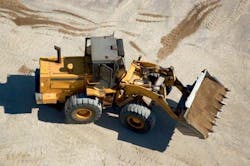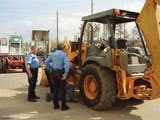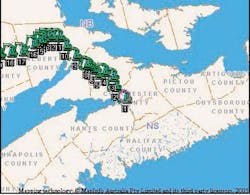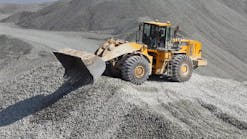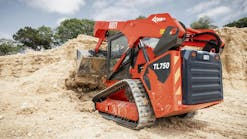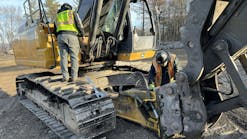Florida police in a January 2009 recovery action zero in on a backhoe loader stolen from an equipment rental company. It was recovered through the use of a LoJack security system installed on the machine. (Photo courtesy of LoJack)
This screen capture from Komatsu'sKOMTRAX shows the movements of a machine loaded on a flat bed trailer. (Image courtesy of Komatsu)
Sign up for ConstructionEquipment.com's Theft Protection newsletter.
Not often do good things come from crime.
The exception, however, could be construction equipment theft, according to Tim Watts, manager, physical damage insurance, Caterpillar Insurance Services.
"The rate of equipment thefts has been significant, and these thefts are what have fueled loss-prevention technologies," Watts says. "Equipment thefts from 1995 to 2001 climbed by 64 percent." When new numbers are compiled, Watts says the percentage may be even higher for this decade.
Theft ranks as the No. 1 reason for equipment loss, Watts says. Fire, vandalism, collisions and overturns are all distant runner-ups.
Only 20 percent of stolen equipment is recovered, according to National Equipment Register (NER). NER is a group primarily funded by insurance companies to maintain national databases of such statistics plus other related data.
Although there are no definitive dollar amounts yet, NER statistics show that equipment stolen annually ranges between $300 million and $1 billion. Last year, 13,511 pieces of construction equipment were stolen. Skid steer loaders and backhoe loaders were the most popular among thieves.
For fleet managers who want to be proactive in loss prevention, three types of technologies are available, depending on equipment application, geography and individual company budgets. These technologies include keyless starting, radio frequency-based technology, and GPS-based technology used in asset-management systems. Such systems also provide equipment location, maintenance information and other data. The third loss-prevention technology, geo-fencing, is an off-shoot feature of asset management systems.
Keyless starting is an up-and-coming technology that became available on selected John Deere machines about nine months ago, according to Jahmy Hindman, product marketing manager. Keyless starting essentially removes the key switch in the cab.
"Up until the technology was introduced not quite a year ago, machine security was difficult to enforce due to proliferation of manufacturers' keys," Hindman says. "This presents somewhat of a challenge in terms of keeping folks who shouldn't be running the machines from doing so."
In John Deere's case, the key switch in the operator's cab has been replaced by a push-button start system. When the security mode is turned on, the operator must enter a personal identification number (PIN) to start the engine.
Even before the PIN code is entered, the technology allows the display of certain basic information—fuel level, engine hours on the machine and battery voltage, for example—that gives service people the basic data they need to service the machine without them having to know the PIN code.
"Without the PIN code, you can push and hold the start button all you want and the engine won't turn over," Hindman says. "When you enter the PIN, the gauge display comes to life showing additional information, such as oil pressure, transmission temperature, and so forth. However, at this point the engine is still not running. The operator can then push and hold the start button and the engine will fire up."
In applications where an operator is on and off the machine numerous times during the day, John Deere has devised a delayed operator logout, Hindman says. "It's a nuisance to have to input the PIN code every time you get on and off the machine, so this device allows the engine to be off for a certain period of time. During that specified time interval, the operator doesn't have to input his PIN again to start the engine."
Hindman says there is a particular concern about equipment loss in urban areas, not only to theft, but to other unforeseen circumstances, such as a kid who takes the machine for a joy ride and abandons it; or a disgruntled employee who cranks up the unit and uses it as a weapon to inflict property damage at a work site.
"Keyless starting also protects against misuse while the machine is in transit," says Hindman. "We've implemented a transport PIN code that allows the equipment to be turned off and restarted for a certain period of engine run time, say 60 minutes. That gives the truck driver plenty of time to start the machine, load it onto the trailer, and back it off when he reaches his destination. What it prevents is for the trucker to stop by his house, dig himself a basement or a swimming pool with the equipment, reload it, and continue on his way. You'd be surprised at the things we run into."
Caterpillar has an on-board control that contains a list of keys in it, according to Steve Morris, commercial parts manager. The keys are pre-programmed by the dealer for the fleet owner. A key that starts the machine must be on that pre-programmed list.
"You can put in a key, but if it's not on the list it won't work," Morris says.
The security system is integrated into the machine electrical system. "If you somehow crank the engine, the security control talks to the engine control on the data link and the engine control turns the fuel injection off. If you get around both of these deterrents—starting and engine fueling—the transmission won't work," Morris says. That technology can be installed on the machine or at the factory or in the field, he added.
For thieves who winch the machine onto a trailer, the machine can be followed by another Cat system that provides GPS tracking.
Radio-frequency technology, another type of theft protection, was introduced to the heavy equipment industry about nine years ago, according to Bob DeAngelis, senior director of LoJack's commercial division. Unlike global positioning systems that bounce signals off satellites and back down to locate a piece of equipment, radio frequency technology is designed to penetrate enclosed areas, such as garages or containers where thieves might hide stolen machines. GPS signals, by comparison, bounce off enclosed surfaces and can't get to the receiver mounted on the stolen unit.
"We've seen a huge demand from equipment owners for our device," DeAngelis says. "It is a system that can be used by small fleets all the way up to major rental companies."
LoJack's radio frequency transmitter is buried deep inside the machine or vehicle. It does not require external components, such as antennae. "We only need to tap into a dedicated power source, either 12 or 24 volts. Once the product is installed, it is forever married to the unit's serial number," DeAngelis says.
"If the equipment is stolen, a signal is transmitted and picked up by law-enforcement agencies that have access to the LoJack security system. The signal sent out by the equipment is silent and the thief never realizes he has touched off an alarm," DeAngelis says. The signal goes to participating law officials who pick up and track the signal to the machine. Other than filing an initial police report, fleet managers don't have to do anything more. They are contacted directly by police who advise them of the recovery.
Since entering the construction market in 2000, Lojack has been involved in the recovery of more than 3,200 pieces of equipment, DeAngelis says, not including machines recovered that didn't have the system on them.
"In many cases, when the LoJack equipment is found, other stolen equipment is also found," he says. "At the end of 2008, we reached a milestone: More than $100 million worth of assets have been recovered in the construction and commercial areas."
LoJack also offers a device designed for asset management called LoCate. It features a combination of GPS and cellular technology and provides real-time asset location, geo-fencing, daily engine hours, and utilization reporting.
It uses a satellite antenna mounted in an open-air location on the machine. "It is not truly a covert system," DeAngelis says. "But its strength, along with the combination of GPS and cellular technology, is that, combined with LoJack, the systems deliver a total solution for asset management and theft protection."
Ken Calvert, director, IT support, for Komatsu, says, "Although helping customers lower owning and operating costs is the primary purpose for our system, KOMTRAX, the GPS system has had several successes helping customers recover stolen machines. In these incidences, authorities went to the last reported machine location and found the unit. Additionally, KOMTRAX has features that allow fleet owners to almost observe progress along a highway when a machine is being moved on a flat-bed trailer."
Lorne Fleming, CEM, director of the equipment division for Grace Pacific, says he is a "big proponent" of GPS.
"This is probably the most significant tool in our arsenal as asset managers," Fleming says. "We all have access to on-board computers and vehicle systems. GPS technology is completely applicable to anything you want to use it for."
A feature of GPS is geo-fencing, where an imaginary fence is positioned around a piece of equipment or around the jobsite itself. A device inside the vehicle "tells the machine it will not go past a certain point," Fleming says. "If it does, the system says, "we are going to tell on you.'"
If the vehicle drives across the geo-fence, the fleet manager is notified immediately that the machine is moving outside the fenced-in area. How the fleet manager is notified depends on how the program is set up, Fleming says. Fleet managers can be contacted by e-mail, computer or telephone, for instance.
Fleming says he has had stolen vehicles recovered through GPS. "Suddenly the GPS pings and if the equipment is not anywhere near our jobsites, but is sitting over in the wacky part of town where someone is getting ready to ship it off to somewhere, you pretty well know you've got a problem."
Fleming, and others interviewed, says if one machine is recovered, the system's paid for itself. Even so, ROI is hard to quantify because if the deterrent technology works, the fleet manager may not know a theft attempt was made unless he finds traces of cut wires or other physical damage when he goes to the work site.
Many larger fleets justify the cost of security technology within the GPS package, which also performs an array of other management duties, such as tracking operating hours, service intervals and, generally speaking, the overall health of the machine.
"That is the attractive thing about the GPS device," Watts says. "It has multiple uses. That multiple use is also one way to justify the return on investment."
With such technology being installed by OEMs and in the aftermarket, it's not surprising that almost all insurance companies offer fleet professionals certain discounts in the form of either a premium credit or a deductible waiver, says Watts.
"Premium credit is a premium reduction," Watts says. "It will apply if the fleet manager has GPS or any other anti-theft device on the machine—and the device is in working order. Insurers offer a variety of premium payment plans to meet their customers' needs—monthly, multiyear or annually—anyway the fleet owner prefers.
"Nearly every policy has a deductible that is required before any payment is made on a loss," he says. "In the event a deductible waiver exists, the fleet manager doesn't have to pay the deductible if he has an operating anti-theft device on the machine when it's stolen."
The amount of the deductibles, Watts says, averages around $1,000, depending on the value of the machine or the entire fleet.
NER's Ryan Shepherd offers candid advice for fleet managers before they rush out and buy the first deterrent technology they see.
"Contractors should be very careful of what service they subscribe to," Shepherd says. "Make certain it is a complementary fit with the area they work in. For instance, if you are a contractor in the State of Montana, you might not want to have a radio frequency type system on your equipment. Radio frequency systems perform better in urban or populated areas where frequency towers are more common. This type of system has a defined market space, so in that regard, the tower transmitters are more effective in higher population zones. Outside those areas—such as Montana—the system becomes less effective or law enforcement doesn't have access to the technology."
Shepherd's second piece of advice is to find out which equipment is more targetable. "If [skid steers] make up 25 percent of your fleet, concentrate on those machines out there on the job —the units that are the biggest target for thieves and have the biggest demand in the black market."
Third, says Shepherd, fleet owners should thoroughly understand the capabilities of the technology they are about to purchase. "Make sure the salesperson explains all the bells and whistles. Make sure you have a good comprehensive understanding of the system you are considering."
Of course, registering equipment with NER is an alternative theft deterrent itself.
